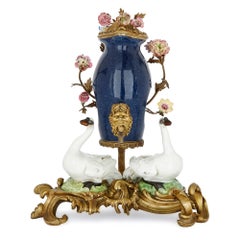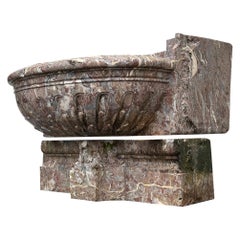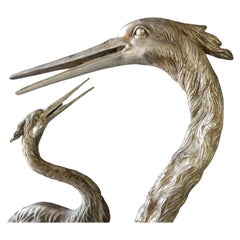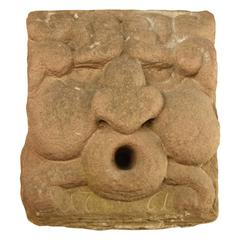Europe - Fountains
2
to
2
10
2
2
2
16
14
7
6
6
5
3
3
2
1
1
1
1
1
1
Height
to
Width
to
1
1
1
1
1
2
1
1
Item Ships From: Europe
Style: Louis XV
Meissen style porcelain and gilt bronze table fountain by Samson
Located in London, GB
This colourful porcelain table fountain, fashioned in the German Meissen style, was crafted in the 19th Century by the French porcelain company Samson et Cie.
The table fountain co...
Category
19th Century German Louis XV Antique Europe - Fountains
Materials
Ormolu
Impressive Fountain Basin And Its Base In Gray Ardennes Marble, 18th century
Located in Honnelles, WHT
Fountain basin and its base in gray marble from the Ardennes. The two elements had to be integrated into the masonry of a facade and surmounted by a niche. gadrooned basin and base c...
Category
18th Century French Louis XV Antique Europe - Fountains
Materials
Marble
Related Items
19th Century Black and Grey Marble Fountain
Located in BARCELONA, ES
Transport your surroundings to the refined splendor of the 19th century with our Black and Grey Marble Fountain. Crafted with meticulous attention to detail, this exquisite piece cap...
Category
19th Century Antique Europe - Fountains
Materials
Marble
Art Deco Era Garden Platinum Goliath Heron Crane Fountain Sculptures 6+ feet
Located in Las Vegas, NV
Magnificent pair of life-size+ bronze Goliath Heron fountain sculptures from the Art Deco era.
What sets these apart from all others is their silver pl...
Category
Mid-20th Century Art Deco Europe - Fountains
Materials
Bronze
H 78 in W 32 in D 14 in
Copper Mermaid Fountain by Glen Mayo
By Glen Mayo
Located in West Palm Beach, FL
Whimsical fountain sculpture, of copper, by metal artist Glen Mayo; its mermaid focal point holding a leaf which cascades water down the fountain, among turtles, angel fish, other se...
Category
1990s North American Europe - Fountains
Materials
Copper
American Cast Bronze Garden Fountain with Figural Boy Holding Koi Fish. C. 1870
Located in Hollywood, SC
American cast bronze garden fountain with standing figural boy holding Koi fish on a two-tiered shell form scrolled base with turtle at his feet, Late 19th century.
Category
1870s American American Empire Antique Europe - Fountains
Materials
Bronze, Copper
H 54.5 in W 28 in D 31 in
18th Century Dutch Carrara Marble Wall Fountain
Located in Baambrugge, NL
18th century Dutch wall fountain from the hall of a canal house. Made of Carrara marble. Antique wall fountain, with a niche-shaped high back including tap hole, on a curled leg with...
Category
18th Century Dutch Antique Europe - Fountains
Materials
Carrara Marble
Antique Fountain Basin in Pink Marble with Masheron, '700 Italy
Located in Cuneo, Italy (CN)
Ancient fountain tub in pink marble, complete with an artificial stone mask in the shape of a lion's face, the base is not included because it is not orig...
Category
18th Century Italian Antique Europe - Fountains
Materials
Marble, Concrete
Wonderful Modernist Kenetic Motion Copper Fountain / Water Feature, Hand Made
Located in Buffalo, NY
Ingenious copper fountain / water feature, solid copper construction, Modernist design Artisan made, hand executed. Sculpture in motion, great for garden, or indoor space.
Category
1970s American Mid-Century Modern Vintage Europe - Fountains
Materials
Copper
Ukiyo Saucer, Concrete Fountain/Fishpond by OPIARY (D50")
By Robert Remer
Located in Brooklyn, NY
Opiary is a Brooklyn-based biophilic design and production studio. We integrate nature in each of our designs, incorporating live greenery and organic shapes into bespoke furniture, planters, and sculpture. Through the ethos of biophilia, our work reflects the shifting, yet timeless relationship between humans and nature.
This modern, minimalist fountain is a tasteful way to incorporate aquatic life into any indoor or outdoor space. The Ukiyo Saucer...
Category
21st Century and Contemporary Modern Europe - Fountains
Materials
Cement
American Giant Stone Frog with Patina, Originally Used as a Fountain
Located in Atlanta, GA
An American giant stone frog from the 20th century, with great patina. Made in the USA in 1987, this giant stone stone frog used to be a fountain (notice the remnants of a pipe below...
Category
1980s American Vintage Europe - Fountains
Materials
Stone
18th Century French White Carrara Marble Fountain Head
Located in Atlanta, GA
A beautifully carved white Carrara marble wall fountain head from 18th Century France with a fluted top, rounded body, with carved leaf border detai...
Category
18th Century French Antique Europe - Fountains
Materials
Carrara Marble
Nude Male Bronze Sculpture Fountain
Located in Malibu, CA
Bronze male sculpture signed. Fonderia Giorgio Sommer Calabritto Napoli
Thomas, sculptor, lived and worked in the Naples area, and especially on Capri, from 1889 to 1906. Given this ...
Category
20th Century Italian Renaissance Europe - Fountains
Materials
Carrara Marble, Bronze
Italian Ancient Marble Sculpture Fountain, Late 16th Century
Located in Milano, IT
Sea monster
Carrara marble mouth fountain
Italy, late 16th century
It measures 13.8 x 31.5 x 18.9 in (35 x 80 x 48 cm)
State of conservation: some small evident gaps and widespread signs of wear due to outdoor exposure. The gray marks crossing it do not come from restoration, but are rather the natural veins of the marble.
This work has some morphological characteristics typically associated with the iconography of the sea monster: an elongated muzzle, sharp teeth, protruding eyes, elongated ears, and a coiled serpent's tail.
An in-depth series of studies on artistic depictions of the sea monster attempted to verify how this symbol evolved in antiquity in the European and Mediterranean contexts and how it gradually changed its image and function over time. The iconography itself is mutable and imaginative and its history is rich with cultural and artistic exchange, as well as the overlapping of ideas. This occurred so much that it is difficult to accurately pinpoint the "types" that satisfactorily represent its various developments.
However, we can try to summarize the main figures, starting from the biblical Leviathan and the marine creature that swallowed Jonah (in the Christian version, this figure was to become a whale or a "big fish", the “ketos mega”, translation of the Hebrew “dag gadol”). Other specimens ranged from the dragons mentioned in the Iliad (which were winged and had legs) to "ketos” (also from Greek mythology), the terrifying being from whose Latinized name (“cetus”) derives the word "cetacean". See J. Boardman, “Very Like a Whale” - Classical Sea Monsters, in Monsters and Demons in the Ancient and Medieval Worlds, in Papers presented in Honor of Edith Porada, Mainz am Rhein 1987, pp. 73-84).
In Italy the monster underwent yet further variations: it can be found in Etruscan art on the front of some sarcophagi representing the companion of souls, while among the Romans we find the “Pistrice” (cited by Plinio in Naturalis Historia PLIN., Nat., II 9, 8 and by Virgilio in Eneide: VERG., Aen., III, 427), which appeared in the shape of a stylized hippocampus or a very large monstrous cetacean and evolved into a hideous being with a dragon's head and long webbed fins.
During the Middle Ages, the sea monster was the object of new transformations: at this time, it is often winged, the head is stretched like a crocodile, the front legs are often very sharp fins - sometimes real paws - until the image merges with dragons, the typical figures of medieval visionary spirituality widely found throughout Europe (on this topic and much more, see: Baltrušaitis, J., Il Medioevo fantastico. Antichità ed esotismi nell’arte gotica, Gli Adelphi 1997).
In Italy during the 15th and 16th centuries, the revival of classicism - representative of the humanistic and Renaissance periods - led to a different reading of these "creatures". Indeed, the sea monster was also to find widespread use as an isolated decorative motif, especially in numerous fountains and sculptures where dolphins or sea monsters were used as a characterizing element linked to water (on this theme see: Chet Van Duzer, Sea Monsters on Medieval and Renaissance Maps, London, The British library, 2013).
From the morphological point of view, the "sea monsters" of this period are mostly depicted as hybrid figures, in which the body of a mythological or real being (a hippocampus, a sea snake, a dolphin), is joined to a head with a rather indistinct appearance. It was usually characterized by large upright ears, an elongated snout, sharp teeth and globular, protruding eyes; a complex and indefinite figure, both from the symbolic point of view and from that of its genesis.
The work we are examining is placed as a cross between the medieval sea serpent and the Renaissance dolphin, with stylistic features which recall the snake as often used in heraldry (such as the "snake" depicted in the coat of arms of the Visconti - the lords and then dukes of Milan between 1277 and 1447 - and which, for some, may be derived from the representations of the “Pistrice” that swallowed Jonah).
In the search for sources, Renaissance cartography and in particular woodcuts should not be neglected. See for example the monsters of Olaus Magnus, from the editions of the “Historia de gentibus septentrionalibus” (“History of the peoples of the north”) and the natural histories of Conrad Gesner, Ulisse...
Category
16th Century Italian Renaissance Antique Europe - Fountains
Materials
Carrara Marble
Previously Available Items
18th Century Carved Stone Gargoyle Head and Water Spout, 1761
Located in Berlin, DE
An 18th century red limestone gargoyle head, depicting a water deity, most likely of the river and functioning as water spout. The head with bulging...
Category
Mid-18th Century French Louis XV Antique Europe - Fountains
Materials
Limestone
Recently Viewed
View AllMore Ways To Browse
Antique French Stone Fountain
Limestone Water Fountain
Large Basins
Circular Fountain
Hand Carved Limestone Wall Fountain
Antique Stone Wall Fountain
Antique Stone Water Fountain
French Limestone Trough
Small Wall Fountain
Used Outdoor Fountains
Wall Fountain Spout
Garden Fountain Lion
Large Italian Limestone
Rectangular Fountains
Round Garden Fountain
Iron Water Fountains
Large Antique Garden Fountain
Iron Water Fountain




